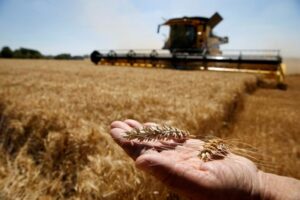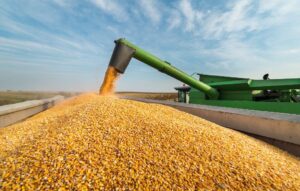
The world’s largest cruise operator Carnival Corp. earned record revenues in the fourth quarter of fiscal year 2023, but ended the period with a slight loss.
According to the company’s press release, the net loss in September-November amounted to $48 million, or $0.04 per share, compared to $1.6 billion, or $1.27 per share, in the same period last year. Adjusted loss decreased to 7 cents from 85 cents per share.
Adjusted EBITDA was positive and amounted to $946 million against minus $96 million a year earlier.
Revenue reached a record $5.397 billion, up from $3.839 billion in the fourth quarter of FY2022.
Analysts on average estimated an adjusted loss of 13 cents per share on revenue of $5.3 billion, according to FactSet.
Revenue from ticket sales in the fourth fiscal quarter increased by 55% to $3.51 billion, and from onboard sales by 20% to $1.886 billion.
For the entire fiscal year 2023, Carnival also received record revenues of $21.593 billion, up from $12.168 billion a year earlier. Adjusted EBITDA amounted to plus $4.23 billion versus minus $1.68 billion a year earlier, adjusted net profit – $1 million versus a loss of $5.51 billion in FY2022.
In FY2024, the company forecasts adjusted EBITDA of $5.6 billion (including about $800 million in the first quarter) and adjusted net income of $1.2 billion (including a loss of $280 million in the first quarter).
The company’s share price is up 3.5% in Thursday trading.

Dneprovagonmash, Ukraine’s largest railcar manufacturer, controlled by businessman Sergiy Tigipko’s TAS Financial and Industrial Group, ended January-September 2023 with a net profit of UAH 51.09 million, up 8.3 times compared to the same period in 2022.
According to the company’s interim financial statements published on Wednesday in the NSSMC’s information disclosure system, its net sales revenue decreased by 14.7% to UAH 724.62 million.
In January-September, the company increased its gross profit by 18.7% to UAH 96.9 million, earning UAH 53.5 million in operating profit (4.6 times more).
The report does not disclose the number of railcars produced and sold in the reporting period.
As before, the report mentions the risk of rising prices for components, materials and energy (material costs account for 80-90% of the cost of production) and lower prices for railcars as price risks for the company.
“Ongoing military operations, uncertainty of further developments, including the intensity or potential timing of the cessation of these actions, may significantly affect the economic situation in the country and, accordingly, the activities of Dneprovagonmash,” the report says.
As reported, in the first half of this year, DVM received UAH 57.85 million in net profit against almost UAH 25 million in losses for the same period last year, with net income growing by 17.2% to UAH 578 million.
Thus, in the third quarter of 2023, the company received a UAH 6.76 million loss against a UAH 31.14 million net profit in July-September 2022, with net income falling 2.4 times to UAH 146.61 million.
“Dneprovagonmash is one of Ukraine’s leading freight car design and manufacturing companies. Its annual production capacity is 9 thousand units.
As reported, an extraordinary meeting of shareholders of DVM JSC on July 25 decided to transform it into TAS Dneprovagonmash LLC.
In October of this year, in cooperation with Austrian partners, the company shipped the first lightweight modular freight cars (MultiBOX) intended for use on the EU railways as part of the TransANT innovation project.
In 2022, DVM’s net income increased by 77.3% to UAH 1 billion 108.7 million, with net profit of UAH 48.64 million compared to a loss of UAH 111.3 million a year earlier. At the same time, sales of railcars increased by 35% to 623 units, and production by 21% to 577 units.
TAS Group was founded in 1998 by businessman Tigipko. Its business interests include the financial sector (banking and insurance) and pharmacy, as well as industry, real estate, and venture capital projects.

The Ministry of Agrarian Policy and Food estimates the harvest of the 2023 season at 79 million tons, which is at least 7 million tons more than last season, Minister of Agrarian Policy Mykola Solsky said on the air of the United News marathon.
“In May, at the beginning of the sowing season, we thought we would have about 63-64 million tons. Then we raised the forecast to 67-68 million, then more – 70 million. Last year we had a result of 7 million tons, then 75 million tons. In the last two weeks, we have been talking about the harvest, which will probably be around 79 million, which is at least 7 million more than last year,” he said.
Mr. Solsky reminded that farmers are no longer concerned about yields and gross output, but rather about the price at which they can sell their crops.
“It is very important that we have the opportunity to sell at a higher price. It is important how much we can export. After all, we need to be able to export 5 million tons of grain every month,” the minister explained, adding that logistics are very expensive and grain is not cheap.
Mr. Solsky emphasized that the demand for logistics is now significantly higher than the supply, and pointed out the importance of balancing these indicators.
“We are trying to do our best to bring this balance closer to what is needed (by the farmer – IF-U), so that the price (of grain – IF-U) will rise,” the minister emphasized.

The Ukrainian Grain Association (UZA) has updated its estimate of the potential harvest in 2023, increasing it by another 3.7m tons to 80.5m tons of grains and oilseeds, up from last year’s figures of 73.8m tons of grains and oilseeds, the association’s press service said.
The increase in this year’s crop forecast is due to favorable weather conditions and better crop yields than expected, although almost 2 million hectares were sown less than last year,” the UZA said.
According to the report, the wheat crop estimate for 2023 improved from 20.2 million tons to 22 million tons (2022 was 20.2 million tons and 2021 was a record 33 million tons). Potential wheat exports in MY 2023/2024 could be around 16 million tons, given the 4.4 million tons of carryover at the beginning of the season.
Barley crop estimate for 2023 is also raised from 5.2 million tons to 5.8 million tons (10.1 million tons in 2021 and 5.8 million tons in 2022), and potential 2023/2024 MY exports are expected to be 3 million tons. Corn crop expectations for the new season have improved slightly further, from 26.9 to 28 million tons (37.6 million tons in 2021 and 27.3 million tons in 2022), while exports could be around 22 million tons.
The sunflower harvest in 2023 is expected to be 13.9 million tons (16.9 million tons in 2021 and 11.1 million tons in 2022), with potential exports of 0.5 million tons. Sunflower processing for oil could reach 13.2 million tons.
UZA estimates the 2023 rapeseed harvest at 4.1 million tons, with exports in MY 2023/2024 expected at 4 million tons; soybeans at 4.8 million tons, with potential exports at 3.3 million tons.
According to the forecast, exports from Ukraine in the new 2023/2024 season could potentially reach almost 49 million tons. Last season, which ended June 30, 2023, UZA estimated exports reached 58 million tons.
The UZA noted that exporting such volumes in the new season will be possible if Ukraine is able to export through its Black Sea ports and if the logistics of alternative routes, including the Danube route, improve and become cheaper.
“The world has already seen that exporting grain through Ukrainian ports and ensuring the safety of navigation in the Black Sea is the only way to quickly and efficiently deliver Ukrainian grain to countries that are in dire need of it,” the industry association explained.
UZA noted that in the conditions of Russia’s blocking of navigation in the Black Sea and its attacks on port infrastructure it continues to work with the European Commission to compensate European carriers for transportation of Ukrainian grain from the border to European ports. This initiative was supported by the European association COCERAL, which has also approached the European Commission. This will allow Ukrainian producers to keep a part of the price, which they are forced to spend now on more expensive logistics, the association believes.
In addition, the problem of increasing the capacity of the Sulinsky Canal on the Danube to ensure its round-the-clock operation and increase the number of pilots is being solved. Work is underway together with the U.S. and the EU to create anchorages in Romanian territorial waters for reloading Ukrainian grain from barges to larger vessels such as Handysize and Panamax, which will make logistics across the Danube more efficient, the UZA said.
“Obstacles to grain exports from Ukraine negatively affect the availability of grain on the world market. According to the US intelligence in a report to the US Congress, Russia’s invasion of Ukraine has caused deep disruptions in global food supplies, raising prices and increasing the risk of food insecurity in poor countries in the Middle East and North Africa,” the business association recalled.
UZA emphasized that rising prices also lead to higher food inflation in developed countries. “In case it is impossible to export products, Ukrainian farmers may reorient their production and give up growing grain, which will further aggravate the crisis in the global food market in the medium term,” the industry association summarized.

The current forecast of rapeseed harvest in Ukraine will be a record and will reach a maximum of 4.2 million tons due to expanded sown areas and high yields, the export potential of the market and its processed products will also reach a maximum, according to the analytical agency Ukragroconsult.
“The key to achieving such results is not only a large harvest and the launch of new processing facilities, but also the solution of logistical issues,” the report says.
According to analysts, in July, the export statistics showed a rather active start of the season, which is important in the absence of a grain corridor. Logistics has shifted to the Danube ports and land routes through the western borders.
Due to the constant attacks on the port infrastructure, the September contracts are focused on the road and rail logistics of rapeseed, experts said, citing information from market participants.
The analytical agency pointed to the change in the geography of exports of rapeseed and its products. Now the sales of Ukrainian rapeseed are focused not so much on the European Union, but on the UK, Switzerland and Bangladesh. The situation is similar with rapeseed oil, which is exported mainly to China and Malaysia instead of the EU market. At the same time, 95% of rapeseed meal goes to the EU market, while the remaining 5% goes to Vietnam.
As of August 22, 2023, Ukraine exported about 500 thsd tonnes of rapeseed and more than 58 thsd tonnes of rapeseed oil, analysts say, adding that current export figures allow us to consider optimistic scenarios.

Agroholding “Kernel”, one of the largest in Ukraine, with a record yield completes harvesting of early grain crops, under which 70 thousand hectares are allocated, the press service of the agroholding reported.
“This year’s winter wheat yield, depending on the region of the cluster location, was from 5.8 to 7.3 tons/ha. The weighted average yield is almost 70% higher than last year’s figure,” the agroholding said on Facebook.
According to “Kernel”, on the post-harvest areas are implemented programs of biologization of farming. To support biodiversity and improve soil fertility, cover crops have already been sown on 22 thousand hectares.
It is noted that agronomic divisions of the agroholding continue to test and research the effectiveness of using different mixtures of cover crops to assess their impact on physical and chemical characteristics, microbiological activity of soil and phytosanitary condition of fields.
Before the war, Kernel Agro Holding ranked first in the world in sunflower oil production (about 7% of world production) and exports (about 12%). It is one of the largest producers and sellers of bottled oil in Ukraine. In addition, it is engaged in growing agricultural products and their realization.
The largest co-owner of Kernel through Namsen Ltd. – is Ukrainian businessman Andriy Verevsky, who this year increased his stake from 41.3% to 74.05% as part of the buyout and delisting of the agroholding from the Warsaw Stock Exchange.
Kernel’s net profit for the first nine months of FY 2023 (July-2022-March 2023) rose 36% to $437 mln, while revenue fell 45% to $2.715 bln.